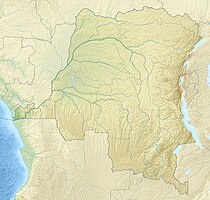Kahuzi-Biéga National Park
|
Kahuzi-Biéga National Park
|
||
|
Eastern lowland gorilla in the Kahuzi Biéga National Park |
||
| location | Sud-Kivu , Democratic Republic of the Congo | |
| surface | 6000 km² | |
| WDPA ID | 1082 | |
| Geographical location | 2 ° 0 ′ S , 28 ° 0 ′ E | |
|
|
||
| Setup date | 1970 | |
| administration | Congolais Institute for the Conservation of Nature (ICCN) | |
| Kahuzi-Biéga National Park | |
|---|---|
|
UNESCO world heritage |
|
| National territory: |
|
| Type: | nature |
| Criteria : | (x) |
| Surface: | 600,000 ha |
| Reference No .: | 137 |
| UNESCO region : | Africa |
| History of enrollment | |
| Enrollment: | 1980 ( session 4 ) |
| Red list : | since 1997 |
The National Park Kahuzi-Biéga (French. Parc National de Kahuzi-Biega ), founded in 1970 by the Belgian Adrien Deschryver, located in the east of the Democratic Republic of Congo , 50 km west of Bukavu in the region South Kivu near the western shore of Lake Kivu and the border with Rwanda . The park is since 1980 UNESCO - World Heritage . It is named after two extinct volcanoes, the Kahuzi (3308 m) and the Biéga (2790 m). The Kahuzi is the highest point in the Kivu region. 90 percent of the 6,000 km 2 park is in the lowlands.
Location and climate
To the west of the mountains of the African Trench is the Kahuzi Biéga National Park at an altitude of 800 to 3400 m above sea level. The temperature varies between 10 and 18 ° C, the annual precipitation is 1800 mm.
Flora and fauna
Overgrown by tropical rainforest, mostly primary mountain forest with bamboo, the park is home to one of the last populations of the eastern lowland gorillas and was the place where Dian Fossey studied the gorillas before moving to Rwanda . The eastern lowland gorilla is the largest form of the gorilla. Due to poaching, the population, which once numbered 14,500 animals, has shrunk considerably.
In total, over 194 species of mammals live in the area. These include the eastern chimpanzee ( P. t. Schweinfurthii ), numerous other species of monkeys, some scattered groups of forest elephants , hippos, leopards, giant forest pigs , bongos and seven different types of duiker. The number of elephants was still 3300 in 1982, favored by the inaccessibility made more difficult by poaching. The park is also home to at least 224 species of birds.
Conflicts and Developments
In 1997 the World Heritage Committee put the park on the Red List of World Heritage in Danger . The lower-lying regions of the park are used by a Rwandan rebel group as a base of operations. She is held responsible for poaching, deforestation and illegal mining ( coltan ). The classification of the Kahuzi-Biéga National Park as a UNESCO World Heritage Site in Africa is therefore not guaranteed (2013).
Criticized by human rights activists and also by Greenpeace was an unsuccessful exclusive nature conservation policy at the time the park was founded, which only contributed to the reduced protection of natural wealth in the area through the expulsion of 6000 pygmies , the traditional hunters and gatherers in the mountains. In 2009 there were only about 3,000 pygmies alive, as many of them died of malnutrition without compensation; The conflicts with the Bantu farmers had prevented a livelihood as arable farmers, only 12 trackers had been hired for tourism in the park. Only a few park guards defended the gorillas from the rebels and civil war refugees. In the meantime, however, with GTZ support , around 450 of the pygmies have been reached with projects for handicrafts and aid for school fees.
swell
- ↑ a b UNESCO World Heritage Center: Kahuzi-Biega National Park. Retrieved August 20, 2017 .
- ↑ United Nations Environment Program : Kahuzi-Biéga National Park, Democratic Republic of Congo. Where (Lead Author); Mark McGinley (Topic Editor). In: Encyclopedia of Earth. Eds. Cutler J. Cleveland (Washington, DC: Environmental Information Coalition, National Council for Science and the Environment). First published in the Encyclopedia of Earth October 15, 2009; Last revised date October 15, 2009; Retrieved June 8, 2011.
- ↑ Alexander Bühler: In the Congo pygmies had to give way to a national park. They were never compensated for the injustice , 1/2009, In: Greenpeace-Magazin , accessed on January 17, 2014.
literature
- Wally and Horst Hagen: The African national parks as habitats for elephants . In: Vitus B. Dröscher : Save the elephants of Africa . 1st edition. Goldmann Verlag , Munich 1992, ISBN 3-442-12322-4 . P. 250.
Web links
- The official blog of the Kahuzi-Biega National Park
- World Heritage sites - Protected Areas Program for Kahuzi-Biéga National park (English)
- Dian Fossey Gorilla Fund (English)
- Entry on the UNESCO World Heritage Center website ( English and French ).
- Justification of the WHC for inclusion in the Red List (English)
- Status report 2006 (PDF; 742 kB), p. 20ff. (English)
- Video (3:28 min): "Reporter's Notebook: A Fragile Optimism for Eastern Congo's Gorillas" , New York Times , March 3, 2009.



